MacGregor Historic Games Rose & Pentagram Design
2229 East 34th Street, Minneapolis, Minnesota 55407
Early Wood Lathes
| Ancient lathes | Continual rotation lathes | Spring-pole lathes |
| Bow lathes | Tools | Related Machines |
| Specialty Lathes | Quotes about turning | Notes on a 17th Cent. turner |
| My bow lathe | Bibliography | Links |
Turning tools & Accesories
17th century turning tools
Most of the gouges are familiar to a modern turner, including some hooked tools for turning the insides of bowls or other containers. Of interest is the tool on the bottom left, which is probably for metal turning, the bend in the tool is hooked on the back edge of the tool rest to privide extra leverage. Two at the bottom right which have teeth on their ends which are used for "chasing" threads,
Source: Mechanick Exercises, or Doctrine of Handy-Works, Joseph Moxon, London 1680.
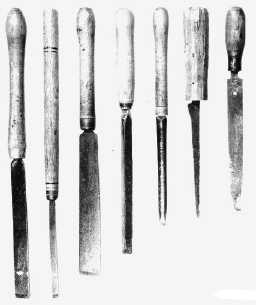 Turning Chisles & Gouges
Turning Chisles & Gouges
Used by the Dominy family 1760-1830. Ranging in length from about 19.25 inches to 13 inches.
Scanned from With Hammer in Hand, The Dominy Craftsmen of East Hampton, New York by Charles Hummel.
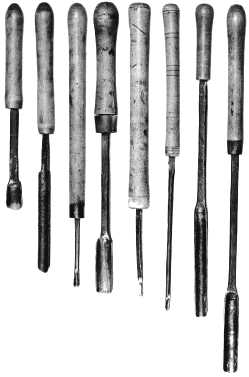
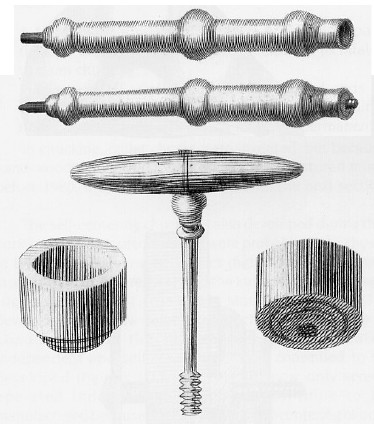 Chucks and a Tap
Chucks and a Tap
Portrayed by Plumier, Above are two Spindle chucks which allow the drive belt to be wrapped around them to turn them. One is concave, possibly with internal threads, the other has a screw projecting from it that the work piece is threaded on.
Below are two simple "jam", or "cup" chucks which merely hold the workpiece by friction and often have slight taper on the inside. The tap is used to thread the hole in base of the cup chuck so it could be screwed on to the the drive spindle of the headstock. The threads on the spindles of lathes did not start to have standardized threads until after about 1841, and so the tap was necessary for making your own chucks even for some time after that.
Scanned from M. Darlow's Woodturning Methods.
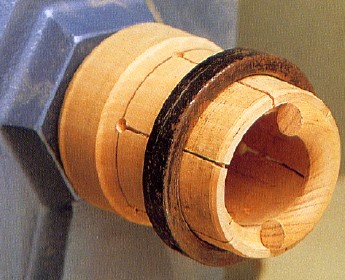 Simple Wooden Spring Chuck
Simple Wooden Spring Chuck
One of the earliest styles of chucks (although mounted on a modern lathe) holding have of a turned ring. The "fingers" are tighted down on the work by forcing the iron ring to the left.
Scanned from M. Darlow's Woodturning Methods.
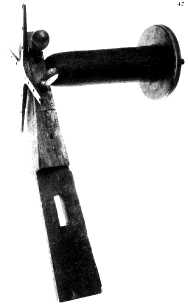 Turning Arbor and Cross
Turning Arbor and Cross
Made in about 1795, it was used with the Dominy family greatwheel lathe for faceplate turning including turning the dished tops of stands and teatables.
Scanned from With Hammer in Hand, The Dominy Craftsmen of East Hampton, New York by Charles Hummel.
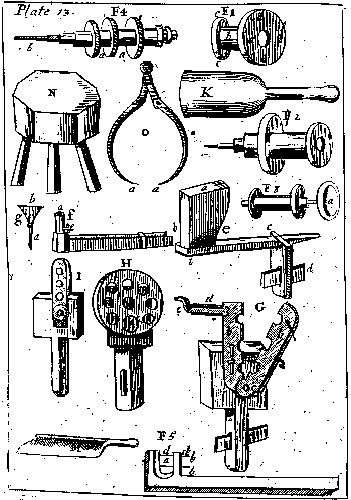 Various Tools and accesories
Various Tools and accesories
. From Mechanick Exercises, or Doctrine of Handy-Works, Joseph Moxon, London 1680.
Below is an modern drawing of a boring collar with a selection of different-sized holes based on a similar idea to the one "H," illustrated by Moxon, but giving a better idea on how it can be used.
Scanned from M. Darlow's Woodturning Technicques.
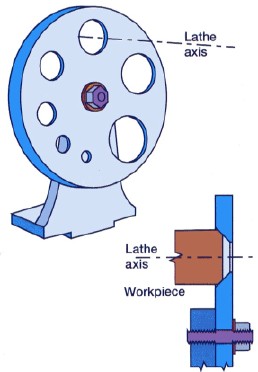
 Drill bits
Drill bits
used used with lathes.
Source: Diderot's Encyclopedia of Trades and Industry. See also Button maker's drills at Related Machines
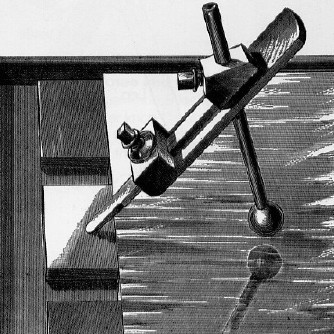 A "Ball-ended Geniostat"
A "Ball-ended Geniostat"
A jig for honing the bevels on round-ended cutters for an ornamental lathe. illustrated in Ornamental Turning, by J.H. Evans (1886).
Scanned from M. Darlow's Woodturning Technicques.